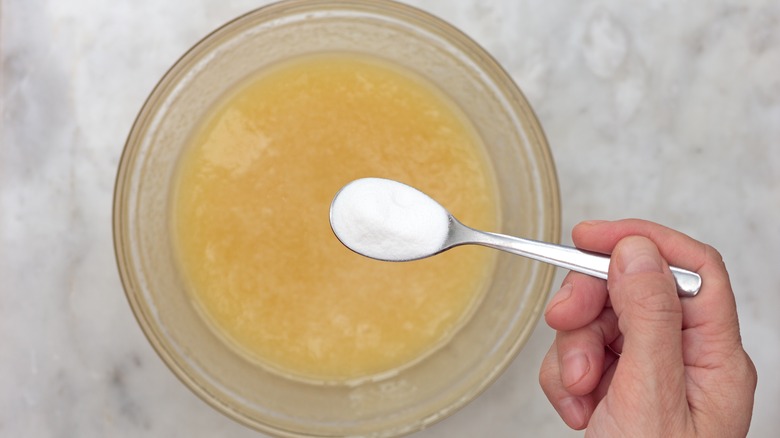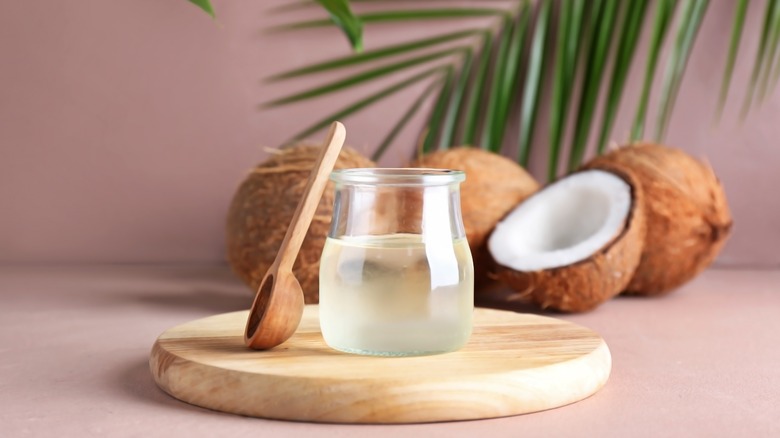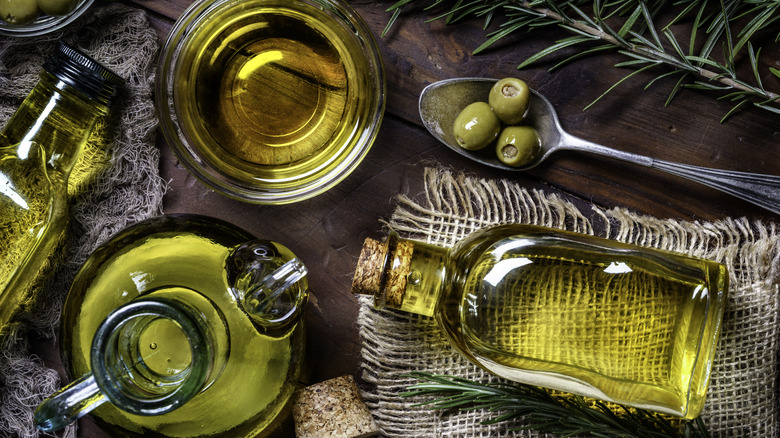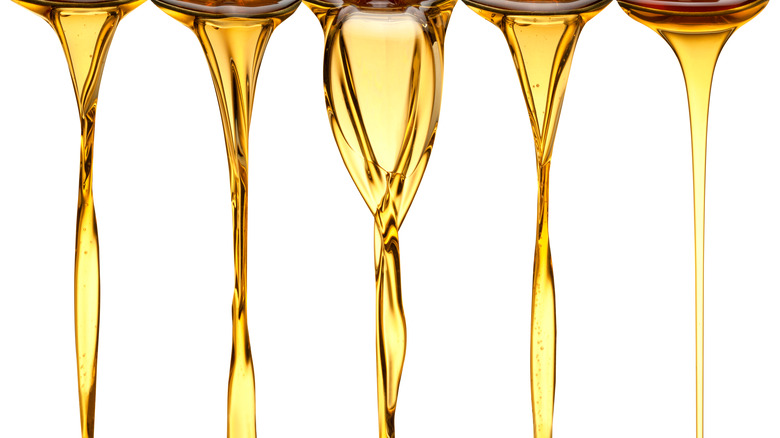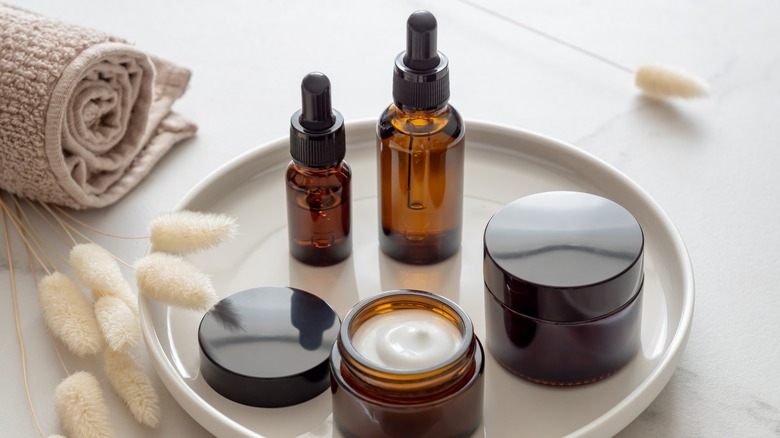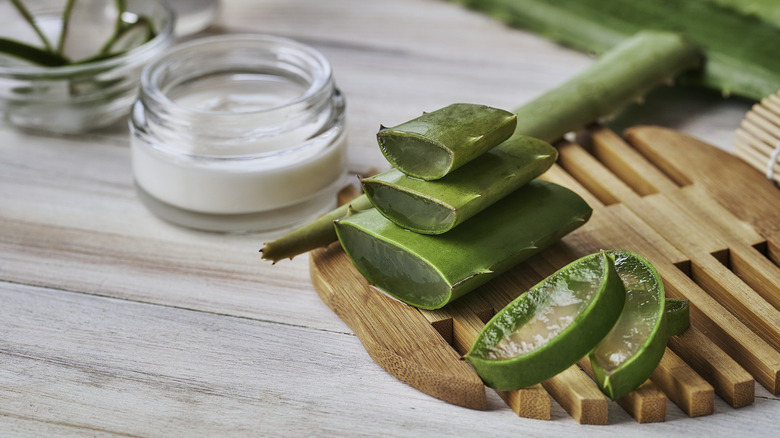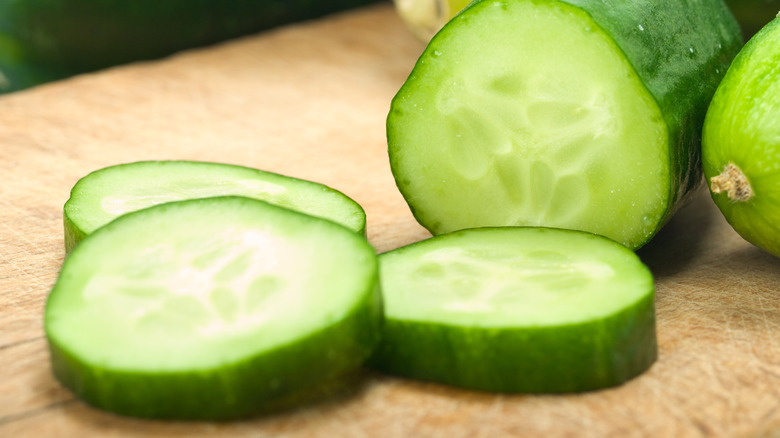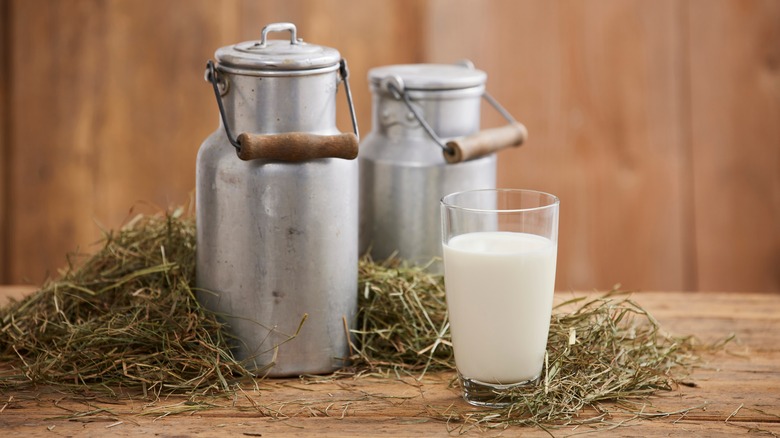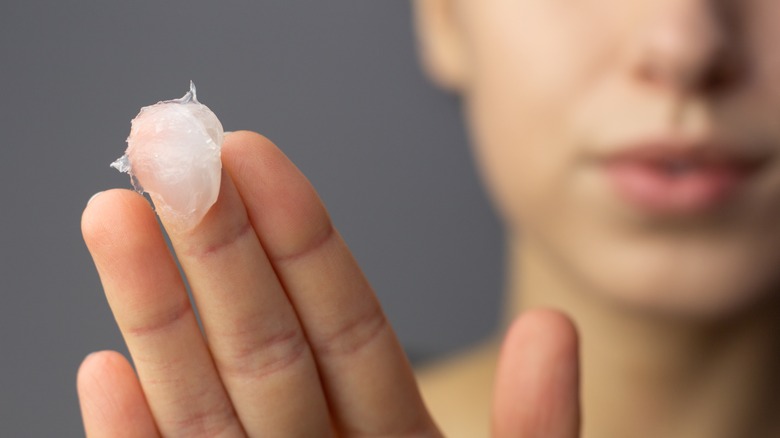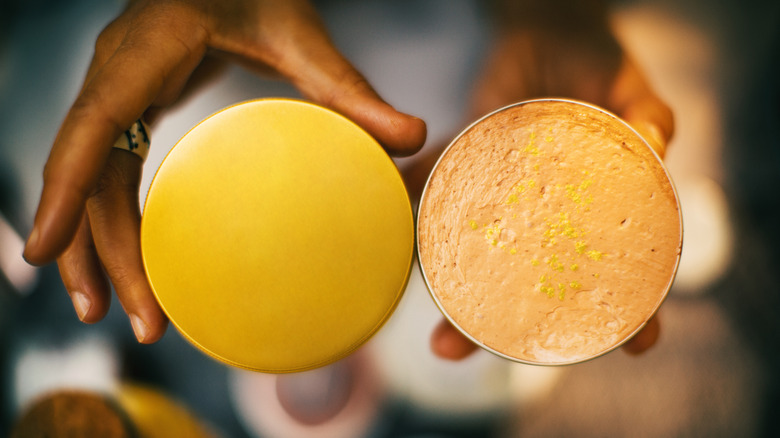Natural Makeup Removers You Probably Already Have On Hand
It's late. You're tired. All you're thinking about is sinking your face into your soft, soft pillow. Unfortunately, when you arrive home, you remember you've still got a face full of makeup on. You begrudgingly open your bathroom cabinet to fetch your cleanser when – uh oh – the void space on the shelf reminds you that you've forgotten to replace your makeup remover.
Before you give up entirely, check out these twelve natural products that can also be used as DIY makeup removers. They're certainly worth a try since you've probably already got them on hand. On top of that, many of them are ingredients in makeup removers that you would find at your drugstore. While it's safest to use skincare products that have been dermatologically tested and approved, these at-home hacks are certainly a wiser alternative to hitting the hay with your makeup still on (which we hope no one is doing, ever).
Combine honey and baking soda for an exfoliating cleanse
For a two-in-one exfoliating and moisturizing cleanse, try a honey and baking soda mixture. Mix half a teaspoon of baking soda into half a teaspoon of honey. Then gently scrub your DIY cleanser onto an already damp face. If you find that the mixture is too thick to work with, add a few drops of water in until you're content with its viscosity.
The mixture works best with raw, unpasteurized honey since honey in this form most consistently demonstrates antimicrobial activity. The honey cleanses and hydrates the face, while the baking soda functions as an exfoliant. The physical act of rubbing the baking soda granules on your face will aid in removing makeup.
Many users love using physical exfoliants because they feel satisfying to scrub. However, this gratifying feeling can encourage over-exfoliation. Excessive scrubbing can create small tears and wounds on your skin, so be very gentle. Additionally, baking soda has the potential to irritate skin since its pH is higher than your skin's. Leaving baking soda on for prolonged periods of time can imbalance your skin's acidity. However, as a wash-off treatment, it is less likely to cause harm, especially for those with normal and insensitive skin types.
Coconut oil to the rescue (once more)
Removing makeup is just one more function we can add to the list of coconut oil's many uses. But how exactly does it work?
Most cosmetics are made using oil- and lipid-based ingredients. Even water-soluble makeup products contain emulsifiers, preservatives, and thickeners which are typically made of fats, also known as fatty acids. Fatty acids and oils attract to other fatty acids and oils. On the other hand, fats and oils repel water. This is why cleansing oils do a better job of disintegrating makeup than just water. They attract the oils in your makeup pulling them off your skin. This is the same mechanism by which coconut oil can remove makeup. Byrdie explains that because the product is typically sold in solid form, you'll want to rub it between your hands to make it easier to spread across the skin. From there, you'll want to gently apply to the face using your fingers only to avoid any potential irritation, and rinse with water when finished.
Healthline warns that people with oily or acne-prone skin should be weary of using coconut oil on their faces. Coconut oil is very comedogenic. This means it has high potential to disrupt the skin's sebum production, thereby clogging pores. Even for individuals with normal to dry skin, most dermatologists do not recommend coconut oil as a leave-on facial product. So, after removing your makeup, be sure to thoroughly wash off any oily residue with soap.
Olive oil is a lighter alternative to coconut oil
For those who are worried about rubbing coconut oil all over their face, olive oil might be alternative oil-based solution that you have handy in your kitchen pantry.
Olive oil, by nature of being an oil that is composed of fatty acids, functions in the same way as coconut oil when it comes to dissolving makeup. However, olive oil is predominantly composed of a unsaturated fatty acids, whereas coconut oil is made of saturated ones. Due to this difference in composition, olive oil has a lower comedogenic rating than coconut oil, making it less likely to clog your pores. This makes it a great alternative for those who have oilier and more sensitive skin types, as well as those who are prone to acne. Having said that, just because it is less comedogenic, doesn't mean you shouldn't follow up with a soapy rinse to remove any residue.
Frankly, any fruit or vegetable oil will work
Alright, so if we're being completely honest, from a purely molecular standpoint, any oil will suffice as a makeup remover. So if you want to save your raw organic coconut oil or extra virgin olive oil for your special skincare moments or your indulgent recipes, grab whichever oil you have in your pantry and massage it on your face and eyes to remove your makeup. The great part is that the fatty acid composition of oils make them all able to remove even the toughest of eye makeup, so you can use the same product all over your face.
While all oils will function well as makeup removers, they are not created equal in terms of how they may affect your skin. For example, argan oil and hemp seed oil have a very low comedogenicity rating, per Fushi Well Being. Jojoba oil actually has a consistency that is almost congruent to that of the sebum on our own skin. They are great options for those who do not want to disrupt their face's natural oil layer.
When used correctly, essential oils could come in handy
Some essential oils are touted for improving skin texture and complexion. Tea tree, orange and peppermint oils have been shown to demonstrate antimicrobial and anti-fungal properties that can be seen when applied topically (via Healthline). If you've got them on hand, you could use them to remove your makeup if you're out of your typical makeup remover.
If your essential oil is 100% pure, it should clearly state so on the label. When this is the case, dilute your oil before applying to your skin, as highly concentrated essential oils are known to cause burns. Essential oils can be diluted in water, or other oils, known as carrier oils. Popular carriers include coconut, olive, or jojoba oil. Start with just one drop of essential oil for every tablespoon of your carrier. Do a patch test on the inside of your wrist and wait for fifteen minutes up to check for reactions. If you do not see a reaction, you can apply the mixture on a cotton pad and use it to remove foundation on your face, avoiding the eye area.
If your essential oil is not labeled as 100% pure, it has likely been diluted with other fillers. Since you may no know how you could react to these, always do a patch test before applying to your face. As well, people who may be pregnant should avoid using essential oils without medical direction.
Aloe vera is a calming cleanser
Although best known for soothing sunburns or wounds, aloe vera gel is a great alternative to traditional makeup remover. Like essential oils, aloe vera is known to demonstrate antimicrobial properties which is why it is included in many skincare formulas. Per Marie France, because of its gentle nature, it is even safe enough to use around the eye area.
If you have aloe gel at home that you purchased, you can apply it directly to the skin, massaging gently to remove makeup. If you need to make it runnier, mix with water in your palms and rub together before applying to your face. If you prefer a thicker consistency, you can even combine it with a carrier oil.
For those who are able to grow their own aloe vera plant at home, Get Busy Gardening explains you can access the gel by breaking a leaf from the plant and letting it drain out. You will see a yellow-ish liquid drip out. This liquid is known as aloin and can be potentially irritating to skin. Allow the aloe vera leaves to drain for at least 15 minutes to ensure the toxin is removed. Then, you can cut the leaf open and squeeze the gel out onto a clean bowl or surface. You can then apply it on your face immediately after for a soothing, non-sticky cleanse.
Cucumber is refreshing and cleansing
Another DIY makeup remover straight from the kitchen – cucumbers! When eaten, cucumbers have the ability to remove waste and toxins from within the body. Per Healthline, these detoxifying properties may be exploited when mashing up the cucumber and applying them topically.
All you have to do is grab a cuke from your fridge and peel the skin off. Mash the "flesh" of the fruit up with a fork, or even get your hands in there. If you prefer a smoother texture without lumps, as this may be easier to apply, use a blender until you're content with the paste you've created. Like aloe vera gel, you can add water or a carrier oil to get the exact consistency you desire.
Once you've created your paste, you can massage it directly onto your face to remove your cosmetics. Since cucumber is a gentler ingredient, you may also be able to use this hack to remove softer eye makeup looks.
Milk is the royal treatment
Hieroglyphics and ancient texts show evidence of Cleopatra bathing in sour milk for her skin's complexion and health. While we don't recommend keeping sour milk in your fridge, the ancient Egyptians may deserve some merit for these practices as raw milk could be a great substitute for your typical cleanser.
Lactic acid is a popular acid that is incorporated in a variety of facial toners and serums. Known for its ability to remove dead skin cells, natural dairy milk and yogurt is full of it. As Dr. Geoffery Rodriguez explains to Reader's Digest, "Milk, which is rich in calcium and vitamins, is extremely nourishing but also very cleansing for the skin."
To use, dip a cotton ball into the milk and gently massage over your face for as long as it takes to dissolve your makeup. Then, wash with water to remove any leftover residue. While raw milk contains the highest concentrations of lactic acid, all dairy milk contains this AHA. So as long as you're not using dairy-free alternatives, this milk wash should work to remove your makeup. Having said that, if you keep non-dairy milks at home because you are allergic to milk or intolerant to lactose, avoid this hack. Even topical applications of milk could trigger a reaction on your face if you are sensitive to dairy.
Baby oil and baby shampoo are gentle, but effective
If you live in a house hold with babies or young children, you might be able to use a combination of baby oil and baby shampoo as a makeup remover. Many skin and hair care products formulated for babies are free of fragrances and surfactants. These ingredients tend to be harsh on the skin. Baby products are formulated to clean effectively while being gentler on the skin. Simply combine one teaspoon of baby shampoo with one teaspoon of baby oil. Then, use your hands to massage the solution into your face. The oil in the mixture will also work to remove heavier eye makeup. Dermatologist Dr. Azi approves of this hack, but she warns against storing this concoction for later use. This is because it is hard to keep track of product expiry dates when they've been repackaged, and the last thing anyone wants to do is use expired products on their face.
Vaseline is a makeup holy beacon
Some makeup artists are using Vaseline as a primer for their makeup to keep their look long-lasting, but did you know Vaseline can also be used to take it off? That's right – even the official Vaseline website claims this jelly can be used to remove makeup.
According to Healthline, similar to oils, petroleum jelly will dissolve even your toughest, most waterproof makeup since the petroleum compounds attract oil and pull them off your face. Contrary to oils though, Vaseline is non-comedogenic. So, despite its thick texture, your face is unlikely to be clogged by the product. This could tempt some to dump your cleanser together, especially since Vaseline doubles as a moisturizer. However, Vaseline is only an occlusive, meaning it will not introduce hydration to the skin, just lock whatever moisture already exists there. Plus, its viscosity could leave you feeling sticky afterward, calling for a foamy cleanser afterward anyway.
Shea butter could surprise you
Shea butter is made from the shea seed. The seed is first boiled in water. Since fats are less dense than water, the fats will float up to the top of the water. Then, the fats are extracted to form the butter (just like regular butter from milk). As we already know, fats attract the lipid compounds in makeup which is why shea butter can be used to pull makeup off your face.
Surprisingly, even though shea butter is a thick moisturizer, it actually has a pretty low comedogenicity rating (via Barkar Shea Butter), making it a good option for oilier or acne-prone skin. Rub the butter in between your fingertips or palms to warm it up until it reaches the consistency of oil. This will make it easier to massage onto your face. You can then let it sit for a few minutes to dissolve your makeup and then rub your makeup off with a soft cotton pad. Even though it is unlikely to clog your pores, repeated use could leave your skin feeling oilier than before so it may still be a good ideas to remove with soap and water afterward.
Plain old lotion, who would've thunk it?
Sometimes, the best solutions are right under our nose (or cabinet). That's right – you can also use plain old face or body lotion to remove your makeup. The preservatives and oils used to thicken your lotion work the same way a natural oil does to remove makeup. Because of this, lotion will even remove your eye makeup. In fact, dermatologist Dr. Azi give this hack a green check.
Having said that, not all lotions are created equal. Some contain more moisturizing agents, others contain more alcohols, while even more drugstore lotions contain fragrances. It may be best to avoid heavily fragranced lotions since fragrances are irritating to facial skin. Of course, if you have no other option, so long as you don't leave your lotion on your skin for too long, and wash it off with soap thoroughly, you're unlikely to experience any harsh reactions.

